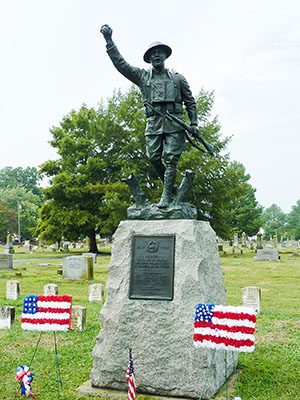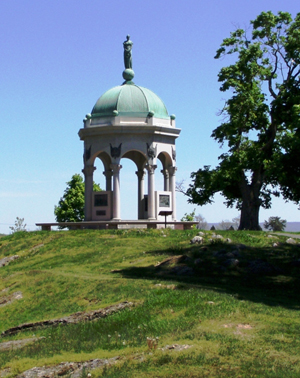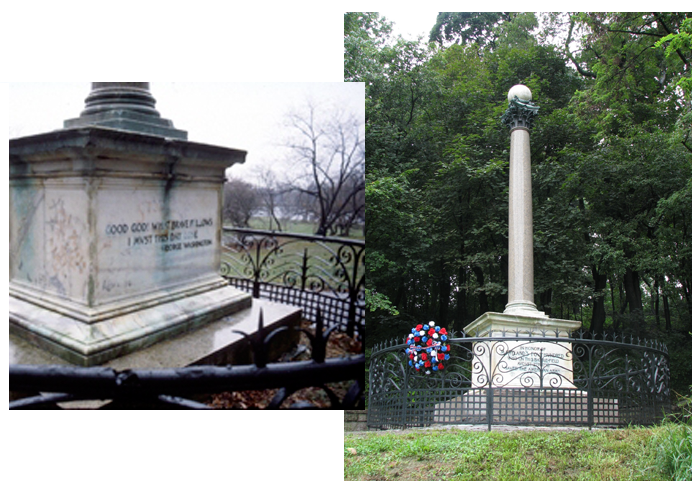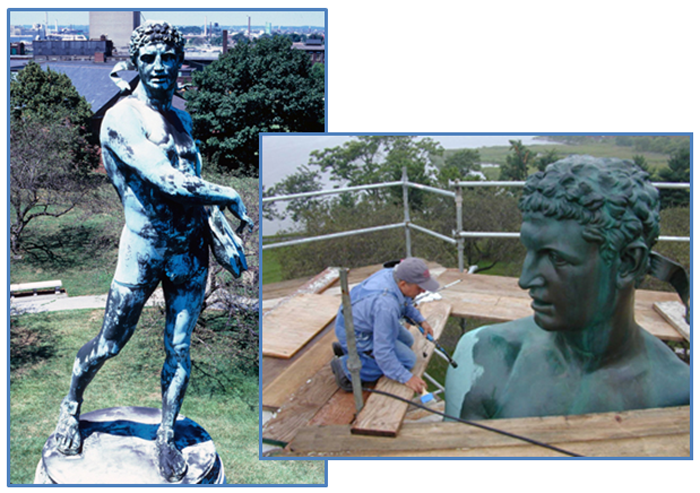 Crisfield World War I Memorial, Somerset County
Crisfield World War I Memorial, Somerset County
Created in 1989 and administered by the Department of Planning, the Commission consists of up to
seventeen volunteer members appointed by the Governor who bring military, historical, business
and government expertise to the important work of safeguarding monuments to Marylanders.
The Commission neither owns nor administers the monuments.
The Commission's work is funded through the annual budget of the Department
of Planning. In addition, donations have been raised through the generous support
of individuals, private groups and veterans' organizations. Additional financial
resources have been provided through community sponsorships and by working with
civic and governmental organizations. In partnership with
the National Park Service, the Commission
has worked to treat monuments at Antietam
National Battlefield, Gettysburg
National Military Park,
Vicksburg National Military Park, and Fort
McHenry National Monument and Historic Shrine. The Commission also has provided
grants to the City of Baltimore in support of its
efforts to conserve the Battle Monument, the Francis Scott Key Memorial Fountain, and the
Samuel Smith and George Armistead monuments on Federal Hill.
 The Maryland Monument, Antietam National Battlefield, Washington County
The Maryland Monument, Antietam National Battlefield, Washington County
Commission members:
- Rebecca Flora, AICP, LEED ND / BD+C, Secretary, Maryland Department of Planning and Chair
- Judge Victor Butanis
- Jenny M. Carson, Ph.D.
- Ellen Chase
- Dr. Roger Anderson Davidson Jr.
- Richard Evans
- Bryan Yukio Fischer
- Alexi Franklin
- Richard Gudnitz
- Nancy Kurtz
- Alfred Mendelsohn
- Dr. Jyoti Mohan
- Lauren Schiszik
- Ray Shipley, Jr.
- Vincent Turner II
- Dolores Zinny
Monuments Commission Projects
The efforts of the Commission have extended throughout the State and beyond, to include
memorials commemorating the contributions of Marylanders on the battlefields of
Gettysburg, Pennsylvania, Brooklyn, New York, and Stephenson, Virginia. Professional
conservation treatment has been provided for life-sized to heroic-scaled sculptures
of bronze, copper, marble, granite, cast concrete, and many smaller reliefs and
tablets. Maryland is home to original memorial works by Edward Berge, Ephraim
Keyser, Joseph Maxwell Miller, Giuseppe Moretti, Charles Henry Niehaus, Hans Schuler, E.M.
Viquesney, Frederick Volk and Stanford White, as well as stock, catalogue-ordered
monuments from the American Bronze Company and the W.H. Mullins Company. Treatments
conform to the U.S. Secretary of the Interior's Standards for the Treatment of
Historic Properties and are administered by conservation and historic preservation
professionals under the direction of the Maryland Historical Trust.
 Monument to the Maryland 400, Prospect Park, Brooklyn, NY, before
and after conservation treatment
Monument to the Maryland 400, Prospect Park, Brooklyn, NY, before
and after conservation treatment
Conservation and Maintenance
The Maryland Military Monuments Commission obtains the services of professional
conservators and historic preservation professionals to determine and carry out
appropriate treatments to care for the monuments. The Commission has established a
program of cyclical bronze maintenance in order to preserve the accomplished work.
Bronze sculpture and tablets in an outdoor environment are exposed to particulates
in the atmosphere which settle onto and corrode the surfaces. In urban and industrial
areas the bronze may become pitted and uneven. Corrosion may follow water runoff
patterns over the surface, forming streaks of light green and black. To respect
the historic integrity of the monuments the Commission follows a minimal and
reversible treatment program, typically water cleaning of bronze sculptures
and tablets followed by the application of a specialized wax to the heated metal. The
wax darkens the bronze and is an economical and maintainable coating that offers
weather protection.
 Francis Scott Key Memorial, Fort McHenry National Monument and
Historic Shrine, Baltimore, before and after conservation treatment.
Francis Scott Key Memorial, Fort McHenry National Monument and
Historic Shrine, Baltimore, before and after conservation treatment.
 Crisfield World War I Memorial, Somerset County
Crisfield World War I Memorial, Somerset County
Created in 1989 and administered by the Department of Planning, the Commission consists of up to
seventeen volunteer members appointed by the Governor who bring military, historical, business
and government expertise to the important work of safeguarding monuments to Marylanders.
The Commission neither owns nor administers the monuments.
The Commission's work is funded through the annual budget of the Department
of Planning. In addition, donations have been raised through the generous support
of individuals, private groups and veterans' organizations. Additional financial
resources have been provided through community sponsorships and by working with
civic and governmental organizations. In partnership with
the National Park Service, the Commission
has worked to treat monuments at Antietam
National Battlefield, Gettysburg
National Military Park,
Vicksburg National Military Park, and Fort
McHenry National Monument and Historic Shrine. The Commission also has provided
grants to the City of Baltimore in support of its
efforts to conserve the Battle Monument, the Francis Scott Key Memorial Fountain, and the
Samuel Smith and George Armistead monuments on Federal Hill.
 The Maryland Monument, Antietam National Battlefield, Washington County
The Maryland Monument, Antietam National Battlefield, Washington County
Commission members:
- Rebecca Flora, AICP, LEED ND / BD+C, Secretary, Maryland Department of Planning and Chair
- Judge Victor Butanis
- Jenny M. Carson, Ph.D.
- Ellen Chase
- Dr. Roger Anderson Davidson Jr.
- Richard Evans
- Bryan Yukio Fischer
- Alexi Franklin
- Richard Gudnitz
- Nancy Kurtz
- Alfred Mendelsohn
- Dr. Jyoti Mohan
- Lauren Schiszik
- Ray Shipley, Jr.
- Vincent Turner II
- Dolores Zinny
Monuments Commission Projects
The efforts of the Commission have extended throughout the State and beyond, to include
memorials commemorating the contributions of Marylanders on the battlefields of
Gettysburg, Pennsylvania, Brooklyn, New York, and Stephenson, Virginia. Professional
conservation treatment has been provided for life-sized to heroic-scaled sculptures
of bronze, copper, marble, granite, cast concrete, and many smaller reliefs and
tablets. Maryland is home to original memorial works by Edward Berge, Ephraim
Keyser, Joseph Maxwell Miller, Giuseppe Moretti, Charles Henry Niehaus, Hans Schuler, E.M.
Viquesney, Frederick Volk and Stanford White, as well as stock, catalogue-ordered
monuments from the American Bronze Company and the W.H. Mullins Company. Treatments
conform to the U.S. Secretary of the Interior's Standards for the Treatment of
Historic Properties and are administered by conservation and historic preservation
professionals under the direction of the Maryland Historical Trust.
 Monument to the Maryland 400, Prospect Park, Brooklyn, NY, before
and after conservation treatment
Monument to the Maryland 400, Prospect Park, Brooklyn, NY, before
and after conservation treatment
Conservation and Maintenance
The Maryland Military Monuments Commission obtains the services of professional
conservators and historic preservation professionals to determine and carry out
appropriate treatments to care for the monuments. The Commission has established a
program of cyclical bronze maintenance in order to preserve the accomplished work.
Bronze sculpture and tablets in an outdoor environment are exposed to particulates
in the atmosphere which settle onto and corrode the surfaces. In urban and industrial
areas the bronze may become pitted and uneven. Corrosion may follow water runoff
patterns over the surface, forming streaks of light green and black. To respect
the historic integrity of the monuments the Commission follows a minimal and
reversible treatment program, typically water cleaning of bronze sculptures
and tablets followed by the application of a specialized wax to the heated metal. The
wax darkens the bronze and is an economical and maintainable coating that offers
weather protection.
 Francis Scott Key Memorial, Fort McHenry National Monument and
Historic Shrine, Baltimore, before and after conservation treatment.
Francis Scott Key Memorial, Fort McHenry National Monument and
Historic Shrine, Baltimore, before and after conservation treatment.